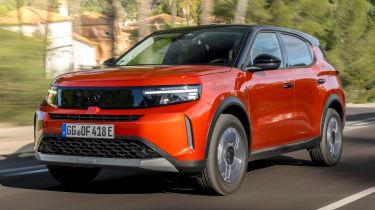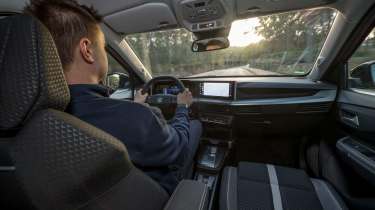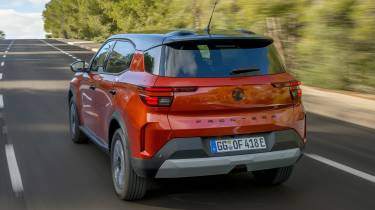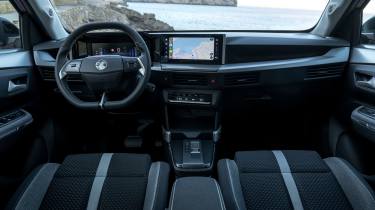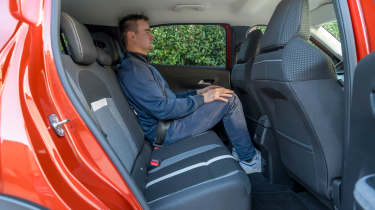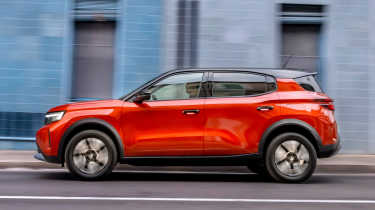Vauxhall Frontera review
The equal price between electric and hybrid versions is the Vauxhall Frontera’s stand-out attribute, although it offers practicality and reasonable running costs too

Is the Vauxhall Frontera a good car?
We often test cars that feel like they’ve been given technology and equipment for the sake of it, so the no-frills approach of the Vauxhall Frontera is deeply refreshing. On paper, the Frontera looks astonishingly good value for money when you compare it with the brand’s more expensive Mokka. It’s much bigger, doesn’t skimp on equipment too much, looks the part and has the option of hybrid and pure-electric power with no cost between them. In the real-world, it lives up to this hype, although interior material quality does bring the tone down slightly.
The driving experience is also uninspiring and we’re yet to be truly convinced by the Electric’s promised range figures. Aside from the excellent levels of practicality, the Frontera’s pitfalls come with the caveat of its price tag, which at £23,500 is extremely appealing. We’re looking forward to seeing a model with a larger battery join the line-up soon, which will boost range to better rival the Mokka Electric.
How much does the Vauxhall Frontera cost?
The Frontera name might not be the most memorable in Vauxhall’s history, but it serves as a foundation for a new C-segment SUV in the range, sitting between the Mokka and Grandland in size.
Crucially, it doesn’t split those two models when it comes to price, however, because the Frontera starts from a Dacia Duster-rivalling price of around £23,500 in both its hybrid and all-electric forms. That’s for the most basic Design trim level, while the higher-spec GS starts from around £2,000 more, with an ‘Ultimate Pack’ available as an extra. This is rather than having Design, GS and Ultimate trim levels as you would in most of Vauxhall’s other models.
The Frontera Hybrid comes with a 1.2-litre three-cylinder turbocharged petrol engine, which is supplemented by a 28bhp electric motor that is built into the six-speed dual-clutch automatic transmission; there’s no option for a manual with the Frontera. A more powerful 136bhp version is available with that same powertrain, although it adds around £1,500 to the Frontera’s price in Design and GS specs.
The all-electric Frontera initially comes with a 111bhp electric motor and a 44kWh battery for a maximum range of 186 miles. A larger-battery Frontera is coming in 2025 with a predicted range of around 248 miles.
The Frontera comes as a five-seater as standard, but something that will help it stand out – not just from the rest of Vauxhall’s SUV line-up but similarly-priced C-segment SUVs – is the option of seven-seats. This will only be available on the GS with the hybrid powertrain and will cost around £550 extra.
Despite being a value-driven proposition, the Frontera still has a relatively decent level of kit. The entry-level Design has Vauxhall’s ‘Pure Panel’ cockpit made up of twin 10-inch displays, wireless Apple CarPlay and Android Auto, wireless smartphone charging and connectivity, four USB-C ports (two up front and two in the rear), rain-sensing windscreen wipers, cruise control and a rear parking camera.
The GS gains automatic air-conditioning, front and rear parking sensors, powered folding door mirrors, blind-spot alert, 17-inch alloy wheels (opposed to the Design’s 16-inch steel wheels), a black roof, tinted rear windows, silver skid plates front and rear, plus LED rear lights.
Engines, performance & drive
| Model | Power | 0-62mph | Top speed |
| Vauxhall Frontera Hybrid 100 | 99bhp | 11 seconds | 112mph |
| Vauxhall Frontera Hybrid 136 | 134bhp | 9.0 seconds | 118mph |
| Vauxhall Frontera Electric | 111bhp | 12.1 seconds | 87mph |
Vauxhall utilised parent company Stellantis’s new Smart Car platform (no affiliation to Smart) for the new Frontera. It’s already been used in the Citroen e-C3 – our Car of the Year in 2024 – so there’s real promise regarding Vauxhall’s new SUV. The French brand’s alternative to the Frontera will arrive in 2025 with the e-C3 Aircross.
We’ve driven both the electric Frontera and the hybrid in the more powerful ‘Hybrid 136’ guise. What was immediately obvious were the similarities between the two cars, which is an impressive feat given the difference in powertrain. There’s slightly more engagement and chassis control with the Vauxhall compared with the Citroen, but as you’d expect, the Frontera won’t be a car you take out for the fun of it.
There’s an almost imperceptible difference between the two powertrains when it comes to ride quality. A decent amount of suspension travel means that speedbumps and potholes are dispatched with well (that’s true for either wheel size), but at higher speeds you’ll notice the Frontera doesn’t quite settle. It’s far from uncomfortable, however, the seats feel strangely hard at first, yet they’re cosseting and supportive in the right areas. Noise levels are a little high and you get the sense Vauxhall could’ve fitted a lot more sound deadening at the cost of weight.
On the subject of weight, it’s a crucial figure behind Vauxhall’s approach to the Frontera and the Smart Car platform in general. The Hybrid weighs 1,344kg in five-seat form and the Hybrid seven-seater weighs just 32kg more. The Electric sits at 1,514kg. Those are all incredibly impressive numbers from a car that is much larger than all of its nearest rivals.
It has an effect on the way the Frontera drives, of course. It’s never going to be something to relish throwing at corners, but crucially the Frontera doesn’t fall apart at the sight of a bend. The steering is light and requires a little more input than you might expect (especially in slow corners), because the Frontera has an urban-friendly 11.05-metre turning circle. The brakes are a little on the spongy side and the six-speed automatic is sluggish to kick down. There’s also not a lot of power to play around with, but the Frontera’s body roll is well contained and there’s genuinely decent levels of grip from the front. We found the Electric to have better corner stability compared with the Hybrid – possibly down to the positioning of the heavy battery low in the body.
The Frontera Hybrid’s turbocharged 1.2-litre three-cylinder and electric motor combine for either 99bhp and 205Nm of torque or 134bhp and 230Nm. The lesser-powered hybrid completes the 0-62mph sprint in 11 seconds before topping out at 112mph, while the more powerful version takes nine seconds and can reach 118mph.
With 111bhp and just 125Nm of torque, the Frontera Electric takes 12.1 seconds to reach 62mph before hitting its 87mph top speed. Weirdly, the Electric’s 111bhp motor doesn’t have the immediacy of an EV from standstill – you have to be up to speed for it to give you some punch – but it doesn’t feel overly slow at any point.
MPG, emissions & running costs
| Model | MPG | CO2 | Insurance group |
| Vauxhall Frontera Hybrid 100 | N/A | 122g/km | N/A |
| Vauxhall Frontera Hybrid 136 | 53.3mpg | 111g/km | N/A |
For a family-friendly, blocky-styled SUV, the Frontera managed to score some useful WLTP efficiency figures. Vauxhall claims the Hybrid 136 will return fuel economy of 53.3mpg. That’s not quite up to the Dacia Duster Hybrid 140, which will do 55.3mpg, nor the MG ZS Hybrid which will return 55.4mpg, but it’s not far off. During our test drive we managed 39.7mpg, although this included a lot of hard acceleration and braking. We expect high 40s to be easily achievable.
The Frontera Electric’s claimed 186-mile range might be rather difficult to match on a routine basis. There’s no heat pump, so you’re at the mercy of the weather conditions. We saw a range figure of around 130 miles, although this was done under plenty of spirited driving.
While the Duster Hybrid has slightly better efficiency figures than the Frontera, the Vauxhall emits 3g/km less CO2 than its Romanian counterpart, at 111g/km. The MG ZS Hybrid is also worse, at 115g/km.
Given the Frontera Electric’s relatively small 44kWh battery, it’ll be able to top up 20 to 80 per cent of its battery in 26 minutes, despite having a fairly average recharge speed capacity of 100kW.
Vauxhall has rolled out its ‘Plug & Go’ offer across its pure-electric models recently and the Frontera also benefits from this. The deal gives the customer £500 towards a home wallbox (an Ohme Pro unit) or online credit with Octopus Electroverse or credit for a Tesco charger.
The ‘Plug & Go’ bonus includes a relatively industry-standard battery warranty for eight years/100,000 miles, plus three years of roadside assistance.
| Model | Battery size | Range | Insurance group |
| Vauxhall Frontera Electric | 44kWh | 186 miles | N/A |
Design, interior & technology
It might be an SUV as with the original Frontera of the nineties, but that’s really where the similarities end with Vauxhall’s newest addition. Up front the new Frontera wears the same ‘Vizor’ headlights and grille arrangement seen across the brand’s entire line up, giving it not only a distinct style to its competitors, but also to its Citroen e-C3 sister car. The Frontera’s blocky side profile and upright stance give it an almost MPV-like shape. Speccing the £400 white wheels and white roof can have a dramatic effect on the model’s style, though, and from some angles it looks like it’s mimicking the Land Rover Defender, especially with Khaki Green metallic paint.
There’s quite a range of paint options with the Frontera. There’s a no-cost basic white to start with, followed by metallic blue, black and silver at around £600, with the Khaki Green and Canyon Orange an extra £100.
Being a value-driven family car, the Frontera doesn’t scream luxury inside – in fact it’s a rather basic affair in there design-wise. It does look much more modern than the old Crossland predecessor, thanks to those twin 10-inch displays and a fairly minimalist layout. There are physical controls for the climate, heated seats and heated steering. But one area where the Crossland is better are the radio controls – annoyingly, they are done either through the central touchscreen or via the steering wheel on the Frontera. It also looks like the tab below the infotainment screen is a Volkswagen-like touch slider, but it’s just a design piece.
The infotainment system is more basic than the version you’d find in the Corsa. It’s incredibly simple, making it easy to navigate, but we suspect the vast majority of drivers will sync their smartphones to the car and make use of the standard-fit Apple CarPlay or Android Auto connectivity.
We poked around both the base-level Design and the higher-spec GS Frontera and at first we didn’t notice a huge amount of difference between the two. There’s some fabric material on the door cards in the GS, which the Design trades for scratchy black plastic, but both cars get the same overall interior layout and Vauxhall’s ‘intelli-seat’ front seats nabbed from the Grandland. The elastic band that wraps around the centre console is quite interesting and means you can fit bottles of all sizes in there.
Sat-nav, stereo and infotainment
The twin 10-inch displays are nicely laid-out on the dash with a slight angle towards the driver. The central touchscreen is within easy reach and while the system took a little while to boot up once for us, it’s responsive to inputs and has a clear display. The menu interface is extremely easy to navigate, although that’s more to do with the fact it’s an incredibly basic set-up. The driver’s display is configurable, but only to a small extent, with efficiency figures and trip information available to view.
Four USB-C ports come as standard on the Frontera, along with a wireless smartphone charger – the latter is positioned in a way that doesn’t let the phone slide around or fall out either (take note MG). Something we’ve come to find on certain Vauxhalls, even the Corsa supermini, is that the firm’s standard sound system is really quite adept.
Boot space, comfort & practicality
| Dimensions | |
| Length | 4,385mm |
| Width | 1,795mm |
| Height | 1,635mm |
| Number of seats | Five/Seven |
| Boot space | 460 litres |
The Frontera is offered in five-seat form as standard with the seven-seater version available on the GS hybrid models for around £550. It’s a C-segment SUV, priced at around B-segment SUV levels, so practicality is a strong point for the Frontera against rivals.
Up front, the Vauxhall feels like a traditional SUV, with a slightly more upright driving position than you get in the Mokka. Despite it being a relatively long car for the class it’s in, it’s a narrow vehicle - reflected inside by the small gap between the two front occupants. There’s a lot of headroom and legroom both up front and in the rear, although you’ll find sitting three adults in the back might be slightly tight. The Frontera also features two ISOFIX fixings on outer rear seats.
The floor is also different between the Frontera Electric and Hybrid. The battery positioning in the Electric means the rear floor is slightly raised compared with the Hybrid. While that means the central ridge is mostly flattened out, your knees are a little higher up. The back of the Frontera is still a perfectly pleasant environment, with a lot of natural light, squishy, comfortable seats and a lot of space.
The boot is big and it’s the same size for both the Electric and Hybrid models, too. At 460 litres, it’s enough to cater to most families, but it’s not quite as much as you get in a Dacia Duster Hybrid (496 litres). The rear row splits 60:40 and the moveable boot floor means you can remove the boot lip, too. Fold the rear seats and the load bay expands to a decent 1,600 litres. Figures for the seven-seater haven’t been revealed, but we expect a significant reduction in boot capacity to accommodate the two extra seats.
Safety & reliability
Neither the Citroen e-C3 nor the Vauxhall Frontera have been tested by Euro NCAP yet, so we don’t know the true safety values of this new Smart Car platform. Vauxhall has given the Frontera a sensible amount of safety equipment as standard, however, so it should score fairly well in Euro NCAP’s ‘safety assist’ category. The Design version gets rear parking sensors, cruise control, lane-keep assist, active safety braking, collision warning, speed-sign recognition, driver-attention alert and a speed-limit indicator. The GS adds front parking sensors and a blind-spot alert to the Frontera’s safety kit.
It’s too soon to give an approximation on reliability for the Frontera given its new Smart Car underpinnings, although the Hybrid’s powertrain has been used in a bunch of other Stellantis products and we’ve heard no horror stories yet.
Given the Frontera’s price point, you’d expect the build quality to be a little questionable, and while the material quality isn’t the best, it mostly feels well screwed together. We couldn’t hear any rattles or feel any nasty vibrations during our test drives.
Vauxhall out-scored Volkswagen, Audi and Renault in our 2024 Driver Power survey, although it only placed 26th out of 32 brands. Stellantis stablemates Citroen and Peugeot came fifth and sixth respectively.
| Key standard safety features | Euro NCAP safety ratings |
|
|
Vauxhall Frontera alternatives
With price parity between the Electric and Hybrid models, Vauxhall has been aggressive with the Frontera’s pricing. The Hybrid has rivals in the shape of the Dacia Duster and when the seven-seater arrives, the Jogger, too. The pure-electric version of the Frontera will have its Citroen e-C3 Aircross sister model to contend with when that arrives in 2025, but not much else besides. While the Frontera definitely feels like a less premium offering than its Mokka cousin, those prioritising space and value will find it virtually impossible to look past Vauxhall’s newest model.
Frequently Asked Questions
The Vauxhall Frontera Electric’s battery warranty is eight years/100,000 miles with three years of roadside assistance as standard.

